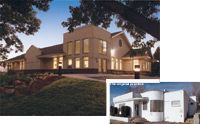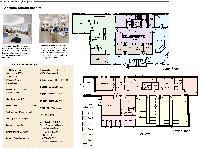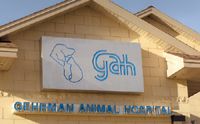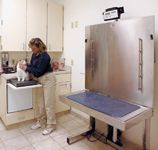Twice the space on half the land
When a seventh renovation on a 1920s roadhouse just wouldn't give Gehrman Animal Hospital the necessary flow, the owners--two brothers--built a new practice.
A man walks into a bar and he sees a box sitting on the counter. His vision is a little blurry, but he makes out that it's not a box—it's a cage with a dog in it. He yells, "Doggie, I know how you feel," and walks back out.

Gehrman Animal Hospital and the original practice (Photos by Greg Wanbaugh, Wanbaugh Studios)
This is no joke. Dr. Fred Gehrman began converting a 1920s roadhouse in Minnetonka, Minn., into Gehrman Animal Hospital in 1942, only days after the bar stopped serving. The weekend he moved in, his first client wasn't the kind of walk-in he'd expected. "Someone forgot to tell the man the bar had closed," says Dr. Chuck Gehrman, the original owner's son, laughing.
The veterinary practice never flowed quite the way the spirits once did, says the next generation of practitioners. The practice had only two exam rooms in Dr. Fred Gehrman's day; when his sons, Drs. Chuck and Bob Gehrman, incorporated in 1979, they converted an old pharmacy into a third. And converting a cat ward into a fourth exam room in the late '90s temporarily accommodated expanding business, but it didn't solve layout problems. "For example, to get to the bathroom, you had to go through either an exam room or the reception area," Dr. Bob Gehrman says.

Award-winning floor plan
Weight-bearing walls blocked additional layout changes. "We realized we would never get the traffic flow we wanted in a building that size," says Dr. Bob Gehrman. "And the value of the land far exceeded the building's value."
The brothers also knew it would be difficult to sell a practice housed in an antiquated facility that would be more than 85 years old when they reached retirement age. They had to build. But where? The available plots were too expensive and too small—except for one of their own, an employee parking lot they'd used since the '50s.

The Gehrmans combined a commercial sign with a residential roof shape and shingles to blend the hospital with surrounding homes and businesses. A façade of commercial stone material meets zoning requirements and balances a homelike brick wainscot.
By reconsidering their assets, the Gehrmans went from a 5,000-square-foot building on two underutilized acres to a 10,140-square-foot, modern hospital on a half of an acre across the street. They hired architect Neil Weber of Weber Architects & Planners in Long Lake, Minn., to develop an efficient two-story floor plan that would work with the parking lot's narrow shape and slope. The result: an innovative hospital design that won Gehrman Animal Hospital a Merit Award in the 2003 Veterinary Economics Hospital Design Competition.
The design is in the details
The brothers say the new plan addressed all of the critical problems from the old facility. "We wanted the exam rooms to be a more comfortable size to accommodate families with multiple animals, a doctor, and an exam room technician," Dr. Bob Gehrman says. The brothers were also ready to grant the employees' request for a larger break room. "We couldn't fit everyone in the room at once," Dr. Chuck Gehrman says.

Four custom workstations for surgical prep, dentals, endoscopy, and general treatment allow flexibility and the ability to treat multiple patients simultaneously. Large windows along the west wall provide a clear view of recovering animals.
The solution: A small coffee room upstairs and a lounge downstairs with a full kitchen, as well as staff lockers, a recliner, and satellite TV. "We wanted the new hospital to be a better place to relax as well as to work," says Dr. Chuck Gehrman. "We're a big family here. We have two employees who've worked here since 1972, and one who's been with us since 1974. We want to see that tradition continue."
With those needs on the wish list, the Gehrmans looked beyond their practice walls to piece together an effective floor plan. After skimming back issues of Veterinary Economics, the Gehrmans visited several hospitals in and around Minneapolis and Rochester, Minn. "The hospital teams we visited all shared their ideas generously, and we made a few of them our own," says Dr. Bob Gehrman. "For example, we borrowed the idea for a rolling track storage system for our medical records."

The main exam rooms contain data port wiring, cable TV ports, central vacuum hookups, refrigerators, and pullout cat scales-originally used as postal scales.
The Gehrmans decided on a team approach to construction, hiring an architect, a general contractor, and a veterinary consultant. "The consultant helped explain our needs for odor and noise control to the architect and contractor, who were both building a veterinary hospital for the first time," Dr. Bob Gehrman says.
The Gehrmans' goal for the new design: to help them provide the highest quality of patient care and client service. Doubling the building's size got them halfway, but they say careful attention to details carried them home.
For example, the brothers made some provisions to meet AAHA accreditation requirements, such as maintaining consistent positive air pressure in the surgical suite. They also added a chemistry hood on the lab counter that vents directly to the outside, dramatically reducing the odor associated with fecal tests.
And furnace and air-handling systems create four zones on the upper level, minimizing odor, pathogens, and sound transfer. The lower level uses an air-to-air heat exchanger. "This setup minimizes heat loss while providing six complete changes of air per hour," Dr. Chuck Gehrman says.
In every exam room, the Gehrmans mounted cat scales on pullout shelving, a design feature the competition judges praised. Just where did this idea originate? "They're actually used postage scales," says Dr. Bob Gehrman. "When we discovered how accurately they weigh small animals, we bought them from one of our receptionists whose husband is in the scale business."
In addition to the usual forced-air heating and cooling system, the Gehrmans laid in-floor radiant heating. "It's like having a 5,000-square-foot radiator under your feet," says Dr. Bob Gehrman. "And we don't even have to touch the thermostat from the time we turn it on in the fall until we shut it off in the spring."
Installing an invisible fence system came from experience. "One of our hospital's resident cats slipped out the door and jumped into a client's car one day," says Dr. Bob Gehrman. "We got a phone call when she got home with one pet too many." And two break-ins led the Gehrmans to link the controlled substance safe with their security system in the new hospital. "Now the system tracks each time the safe is opened and closed," he says.
Dreams become concrete
The Gehrmans polished their design at the 2001
Veterinary Economics
Hospital Design Conference. "We were exposed to so many new materials there," says Dr. Bob Gehrman. "For example, we decided to put porcelain tile in the reception area when we learned that it chips less visibly than ceramic tile. And we used epoxy grout to reduce urine absorption."
During construction, as many as three planning meetings a week kept the new building on schedule and helped the team anticipate problems. Meanwhile, the brothers spent two months wading through all of the equipment, supplies, and paperwork of 60 years of practice. They recovered a few antiques along the way: Their father's radiograph and cautery unit are among items the brothers plan to donate to the Minnesota Veterinary Historical Museum.
When it came time to move, the Gehrmans had only one weekend to get the practice across the road and up and running again. They relied on a pair of longtime clients to coordinate the parade of boxes, supplies, and equipment, color-coded by room.
The Gehrmans have found that the spacious setting agrees with their service goals, as well as their contracted service providers—a groomer, radiologist, and surgeon. "We are now the complete service facility we've always wanted to be—with ample room to grow," Dr. Chuck Gehrman says. The first year in the new building, the practice enjoyed a 12.75 percent revenue growth.
"Clients often tell us they appreciate the size of the waiting room and how bright it is," says Dr. Bob Gehrman. "That's good to hear, because we tried to incorporate as much natural light as possible throughout the building. We wanted to be able to look out—and we wanted people to be able to look in."
Editors' note: Preparing to build? For more design tips, photos, floor plans, and articles—or a Veterinary Economics Hospital Design Competition entry form—visit www.HospitalDesign.net